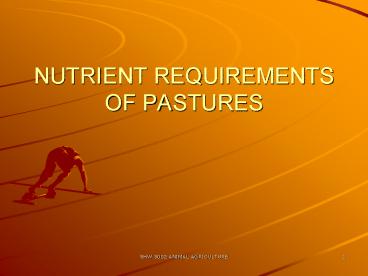NUTRIENT REQUIREMENTS OF PASTURES - PowerPoint PPT Presentation
1 / 34
Title:
NUTRIENT REQUIREMENTS OF PASTURES
Description:
NUTRIENT REQUIREMENTS OF PASTURES SHW 3002 ANIMAL AGRICULTURE * END * Why pastures have to be fertilized Nutrients are removed from soil by pastures Soil is not able ... – PowerPoint PPT presentation
Number of Views:94
Avg rating:3.0/5.0
Title: NUTRIENT REQUIREMENTS OF PASTURES
1
NUTRIENT REQUIREMENTS OF PASTURES
2
Why pastures have to be fertilized
- Nutrients are removed from soil by pastures
- Soil is not able to completely supply the
required nutrients
3
Nutrient uptake per year (kg/ha)
Species Yield t/ha N P K Ca Mg
Brachiaria ruziziensis 32.9 333 54 442 150 77
Pennisetum purpureum 27.7 332 70 554 105 69
Panicum maximum 25.3 317 48 399 163 109
4
Deficiency Symptoms
- NITROGEN General chlorosis of leaves with older
leaves first showing symptoms
5
NITROGEN DEFICIENCY
- Potato leaves
- Left normal green leaf with sufficient nitrogen
supply - Right nitrogen deficient leaf, pale green and
yellow tinted
6
Deficiency symptoms
- Phosphorus Leaves become purple or red in the
veins. Early symptoms, leaves dark green in
colour
7
PHOSPHORUS DEFICIENCY
- May develop purplish or reddish colour on leaves
- Premature leaf loss
- Poor root development
- Delayed maturity
- Decreased yield
Rice plant under P-deficiency, stunted with
limited tillers, narrow, short, erect and dirty
dark green leaves.
8
Deficiency Symptoms
- Potassium (K) yellow spots leaves scorching on
leaf margins and leaf tips
9
(No Transcript)
10
Deficiency symptoms
- Magnesium Interveinal chlorosis and necrosis.
Deficiency causes hypomagnasaemia in animals
11
- Lower leaf interveinal chlorosis in Gerbera.
- Geranium - lower leaf interveinal chlorosis.
Notice the initial (left) versus advanced (right)
interveinal chlorosis.
12
Fertilizers
- N urea (contains 46 N)
- P Triple Superphosphate (TSP) contains 21 P
- Rock phosphate (about 15 P)
- K Muriate of Potash (contains 50 K)
13
Basal Fertilization
- During Planting
- N 50 kg/ha
- P 50 kg/ha
- K 50 kg/ha
14
How much fertilizer?
- 50 kg N 100/46 x 50 kg urea
- 50 kg P 100/21 x 50 kg TSP
- 50 kg K 100/50 x 50 kg MOP
15
Maintenance FertilizerPure grass pastures -
grazed
- N 200 to 400 kg/ha per year
- Applied 4-6 times per year
- P 40-80 kg/ha
- K 75-100 kg/ha
- Applied 1-2 times a year
16
Maintenance FertilizerGrass Legume Pasture
- N 0
- P 40 80 kg/ha
- K 35 60 kg/ha
- Applied 1-2 times a year
- Micronutrients
- 5-8 kg/ha Copper sulphate
- 5-6 kg Zinc sulphate
- 200 g/ha molybdenum
17
Cut Fodder Grasses
- N 50 kg/ha (after every cut)
- P 40 kg/ha (after 3 cuts)
- K 50 kg/ha (after 3 cuts)
18
NITROGEN
19
Importance of N in pastures
- Needed in large quantities for maximum growth
up to 800 kg/ha per year - Most soils cannot supply the required rate
- N from fertilizers are soluble and easily leached
- N supply also affects protein content
20
N effects on dry matter yield
21
N effects on crude protein content
22
Sources of N
- Organic matter in soils
- N fertilizers
- N fixation by legumes
- N fixation by bacteria and algae
- In rain water
23
Nitrogen in Soils
- Stored in organic matter to depth of 90 cm from
surface
24
Biological N fixation (Bionif)
- Legumes as host in symbiotic association with
Rhizobium - Rhizobium forms nodules in roots
- Effective nodules are large and pink in colour
(leghaemoglobin) - Ineffective nodules are small in size and pale in
colour
25
Biological N fixation
26
- Rhizobium converts N from atmosphere into nitrite
and nitrate - Rhizobium requires supply of micronutrients such
as Mo, Cu, B for this process - Rhizobium is inhibited by presence of nitrates in
soils
27
Amount of N fixed by legumes
- Varies with types of legumes and Rhizobium
strains - Temperate legumes (e.g. in NZ) 280-400 kg N/ha
per year - Good tropical legumes 170 280 kg N/ha per
year - Moderate tropical legumes 55-170 kg N/ha per
year
28
Rhizobium inoculation
- Inoculation necessary only when soils have never
had legumes grown on it - Rhizobium is cultured in peat
- Seeds of legumes are mixed with peat culture
before sowing - Use of sticker and pelleting with TSP helps in
inoculation
29
Recycling of N
- 75 of N ingested by animals are returned through
urine, but 45 is lost through volatilization or
leaching - 17 of N ingested by animals are returned through
faeces and 6 lost through volatilization and
leaching
30
N Cycle
31
Transfer of N from legumes to grass
- Direct transfer (amino acids from roots of
legumes to grass) - Decomposition of roots and rhizobium (1-5 kg N/ha
per year) - Decomposition of leaves and stems of legumes
- Through grazing animals (85 of N is returned)
32
Problems in maintaining legume-grass pastures
- Legumes are intolerant of heavy grazing
- Many pasture grasses dominate legumes when soil
fertility is high - Animals sometimes select for legumes
- Legumes are sensitive to nutrient deficiencies
33
Grass-legume vs Grass-N
- Low cost
- Limited yield
- High nutritive quality
- Not tolerant to heavy grazing
- Not suitable for cut and carry
- High cost of fertilizer
- High yields
- Moderate nutritive quality
- Tolerant to heavy grazing
- Suitable for cut and carry
34
END































